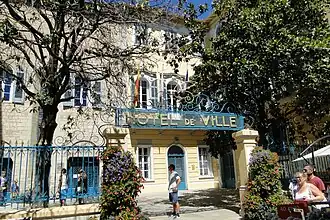Hôtel de Ville, Draguignan
| Hôtel de Ville | |
|---|---|
 The main frontage of the Hôtel de Ville in August 2017 | |
| General information | |
| Type | City hall |
| Architectural style | Neoclassical style |
| Location | Draguignan, France |
| Coordinates | 43°32′18″N 6°27′48″E / 43.5382°N 6.4634°E |
| Completed | c.1791 |
The Hôtel de Ville (French pronunciation: [otɛl də vil], City Hall) is a municipal building in Draguignan, Var, in southeastern France, standing on Rue Georges Cisson.
History
The Hôtel de Ville is situated within the grounds of the Couvent des Cordeliers (Convent of the Cordeliers) which dates from 1265.[1] The convent was built on a route known in the Middle Ages as the Iter Regius (Royal Journey), linking the Rhône Vally to northern Italy,[2] and was managed by the Franciscans.[3] Notable visitors included Saint Louis in 1295 and Antipope Benedict XIII in 1404.[1] The design involved a single nave with a ribbed vault and an apse.[4][5]
After the convent was confiscated by the state as biens nationaux (for the good of the state), the friars were driven out and it was acquired by the town council in 1791.[6] The council also acquired an adjacent hôtel particulier, Hôtel Thomé de la Plane.[7][8] This enabled the council to consolidate the site with a series of buildings placed around a courtyard. At the back of the courtyard, the old convent building was to the left and a new municipal building to the right. The new municipal building had a main frontage of just three bays. The central bay featured a round headed doorway with a keystone, which was flanked by a pair of casement windows. The building was fenestrated by three round headed windows with curved cornices and shutters on the first floor and by three segmental headed windows with shutters on the second floor. Meanwhile, the original convent building was converted to create a Salle des Mariages (wedding room).[9]
After the Second World War, the road in front of the town hall, Rue Nationale, was renamed Rue Georges Cisson to commemorate the life of the former local commander of the French Resistance who was arrested by the Gestapo and executed at Signes on 18 July 1944.[10][11] This was less than a month before the liberation of Draguignan by American troops during Operation Dragoon on 16 August 1944.[12]
A large mural, painted by Vincent Fichaux and Michel Crosa, which depicted the legend of Saint-Hermentaire slaying a dragon in the 5th century, was unveiled in the original convent building in May 2013.[13][14]
References
- ^ a b Lemaître, Henri (1908). "Frédéric Mireur: Les anciens couvents de Draguignan. Les Cordeliers". Bibliothèque de l'École des chartes. pp. 219–220. Retrieved 8 August 2025.
- ^ "Histoire de la Ville". Town of Draguignan. Retrieved 8 August 2025.
- ^ "Cordeliers". The Cyclopedia of Biblical, Theological, and Ecclesiastical Literature. Retrieved 8 August 2025.
- ^ Louis, Serbat (1907). "Église et couvent des Cordeliers de Draguignan". Bulletin Monumental. p. 377. Retrieved 8 August 2025.
- ^ "Draguignan: Couvent des Cordeliers (1904–1905)". Archives of Var. Retrieved 8 August 2025.
- ^ "La Balade Médiévale à Draguignan" (PDF). Résine Média. p. 10. Retrieved 8 August 2025.
- ^ Rinaudo, Yves (1987). Le Var autrefois. FeniXX réédition numérique. p. 95. ISBN 9782402566209.
- ^ Gayol, Georges (2000). C'était notre Draguignan 1925–1955. Impr. Bonnaud. p. 285.
La mairie constituée de l'ancien hôtel particulier Thomé de la Plane, d'une partie du couvent des Cordeliers et de sa chapelle.
- ^ "L'hôtel de ville avant 1914". Archives of Var. Retrieved 8 August 2025.
- ^ "Cisson Georges, Félix, Joseph, Marie [Pseudonymes dans la Résistance : Lebrun, Lucien, Roumi, Dubosc". Le Maitron. Retrieved 8 August 2025.
- ^ "Georges Cisson". Le Musée de la Résistance en ligne. Retrieved 8 August 2025.
- ^ "Draguignan Liberation Memorial". American War Memorials Overseas. Retrieved 8 August 2025.
- ^ "Une fresque forte de symboles à la mairie de Draguignan". Var-Martin. 6 May 2013. Retrieved 8 August 2025.
- ^ "France, Var, Draguignan, fresco depicting St Hermentaire killing the dragon in the City Hall lobby, the mayor Richard Strambio left". Bertrand Rieger. Retrieved 8 August 2025.